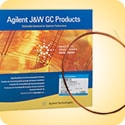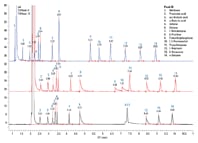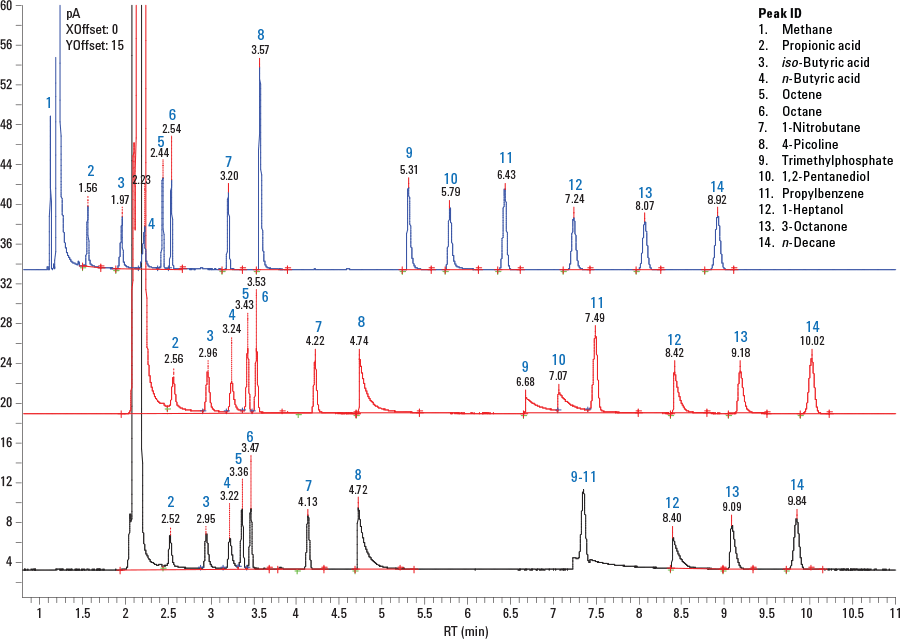Access Agilent eNewsletter, January 2015
>> Update My Profile | Subscribe to Access Agilent | Article Directory

Agilent J&W Ultimate Plus deactivated fused silica tubing for better GC and GC/MS trace analysis
By Ngoc-A Dang
Agilent GC Research & Development
Deactivated fused silica tubing is widely used for guard columns, restrictors, transfer lines, or retention gaps in GC and GC/MS applications with heavy matrix, and for analysis of semivolatile compounds. High inertness is a key requirement for the accurate and reproducible measurement of more reactive compounds at trace levels, to minimize analyte degradation and reduce peak tailing. Building on long experience in developing deactivation chemistries for capillary tubing, Agilent has released Agilent J&W Ultimate Plus fused silica, a novel fused silica for GC and GC/MS applications.
To demonstrate the superior capabilities of Agilent J&W Ultimate Plus fused silica tubing, we first compared it with deactivated fused silica tubing from another supplier using a chromatographic test for inertness, measuring peak asymmetry and relative recoveries of several compounds. We then conducted a second comparison test using drugs of abuse as analytes. These compounds are well recognized as chemically active because they often adsorb onto active sites in the GC flow path.
 Enlarge
Enlarge
Figure 1. The tandem-column setup of system test (A) and Agilent/other supplier tubing test (B).
 Enlarge
Enlarge
Figure 2. Comparison of different types of tubing, 6 m × 0.53 mm, using Very Inert Test Mix 2. Top – system test, middle – Agilent J&W Ultimate Plus fused silica tubing, bottom – Silconert2000 tubing, with small, tailing peaks and apparent coelution with n-propylbenzene.
Greater inertness with Agilent tubing
We used a tandem-column setup (Figure 1) with an Agilent J&W VF-5ms GC column at 60 °C. A system test was initially performed to establish the base level inertness profile, in which a piece of reference column was connected to a flame ionization detector (Figure 2, top).
Next, the Ultimate Plus fused silica or fused silica tubing from another supplier was replaced to connect to the detector. The inertness of the tubing was evaluated with respect to peak asymmetry and recoveries of compounds in two test mixtures. Compounds known to adsorb onto active sites of tubing (for example, 1-decanol, 4-picoline, trimethyl phosphate, and 1,2 pentanediol) provided an effective evaluation of tubing inertness.
Ultimate Plus fused silica clearly showed significantly improved inertness compared to tubing from another supplier. Trimethyl phosphate, 1,2-pentanediol, and n-propylbenzene (compounds 9-11) were separated when using Agilent tubing (Figure 2, middle), but trimethyl phosphate and 1,2-pentanediol were strongly adsorbed on the active surface of other supplier tubing. As a result, peaks were small with heavy tailing, which resulted in apparent coelution with n-propylbenzene (Figure 2, bottom).
Peak asymmetry values of a nonpolar compound (n-decane) were similar for types of tubing. These values were close to 1, which is defined as the asymmetry factor of an ideal peak. However, peak asymmetry factors of a polar compound (1-decanol) using Agilent tubing were closer to 1 than those of the other supplier’s tubing, in a variety of internal diameters. Differences were more significant with larger id tubing. This indicated the improved inertness performance of Ultimate Plus fused silica, explained by interactions between polar compounds and active sites on the tubing surface that increases peak asymmetry of these compounds. Better relative recoveries of 1-decanol (compared to n-tridecane) were also found for Agilent tubing. You will find full details of this work in Agilent publication 5991-5142EN.
More accurate results for drug screening with Agilent Ultimate Plus
The identification and quantification of drugs of abuse in different types of biological samples such as urine or blood, is important to forensic and clinical toxicology. GC/MS is still regarded as the ‘gold standard’ for drug confirmatory analysis or for screening tests, because of its high sensitivity and selectivity for determination of drugs and their metabolites at trace levels. Without derivatization prior to GC, drugs of abuse are well known as chemically active compounds. This results in poor peak shape, poor quantification, and peak disappearance of some highly active analytes.
 Enlarge
Enlarge
Figure 3. An overlay of total ion current chromatograms of 5 ng/component on-column of a drugs of abuse checkout mixture with Agilent Ultimate Plus deactivated fused silica tubing (green chromatogram) or deactivated fused silica tubing from another supplier (red chromatogram) used as GC restrictors for MSD.
In another comparison, we used an Agilent J&W DB-5ms Ultra Inert GC column in an Agilent 7890 Series GC system equipped with a 5975C MSD and triple-axis detection. Figure 3 is an overlay of total ion current chromatograms of 5 ng/component on-column of the drugs of abuse checkout mixture. Ultimate Plus (green chromatogram) and deactivated fused silica tubing from another supplier (red chromatogram) were alternately installed as GC restrictors to the MS interface.
It was clear that Agilent Ultimate Plus fused silica tubing improved inertness performance compared to tubing from another supplier, because of better responses of most of the analytes in the checkout standard. Full details of this application, showing comparable results at 1 ng/component on-column, are available in Agilent publication 5991-5303EN.
Improved inertness, higher sensitivity, and increased reproducibility for active analytes
We’ve shown you how Agilent GC solutions has successfully minimized active sites throughout the flow path of GC/MS systems, which allows direct analysis of underivatized analytes, with high sensitivity and reproducibility. These efforts improved the inertness of flow path components that directly contact with analytes. Learn how Agilent Inert Flow Path solutions and Agilent J&W Ultra Inert GC columns can help you meet ever-increasing demands for reduced detection limits of active analytes. Then try out the Agilent J&W GC Column Selection Tool to find the right column for your application.
>> Update My Profile | Subscribe to Access Agilent | Article Directory
Figure 2.

Comparison of different types of tubing, 6 m × 0.53 mm, using Very Inert Test Mix 2. Top – system test, middle – Agilent J&W Ultimate Plus fused silica tubing, bottom – Silconert2000 tubing, with small, tailing peaks and apparent coelution with n-propylbenzene.
Figure 3.

Peak No. |
Compound |
|---|---|
1 |
Amphetamine |
2 |
Phentermine |
3 |
Methamphetamine |
4 |
Nicotine |
5 |
MDA |
6 |
MDMA |
7 |
MDEA |
Peak No. |
Compound |
||||||||||||||||||||||||||||||||
|---|---|---|---|---|---|---|---|---|---|---|---|---|---|---|---|---|---|---|---|---|---|---|---|---|---|---|---|---|---|---|---|---|---|
8 |
Meperidine |
||||||||||||||||||||||||||||||||
9 |
Phencyclidine |
||||||||||||||||||||||||||||||||
10 |
Methadone |
||||||||||||||||||||||||||||||||
11 |
Cocaine |
||||||||||||||||||||||||||||||||
12 |
Proadifen (SKF-525a) < | 12 |
Proadifen (SKF-525a) |
||||||||||||||||||||||||||||||
13 |
Oxazepam |
||||||||||||||||||||||||||||||||
14 |
Codeineiv>
An overlay of total ion current chromatograms of 5 ng/component on-column of a drugs of abuse checkout mixture with Agilent Ultimate Plus deactivated fused silica tubing (green chromatogram) or deactivated fused silica tubing from another supplier (red chromatogram) used as GC restrictors for MSD. |
